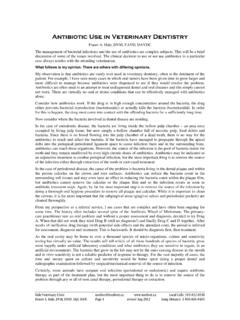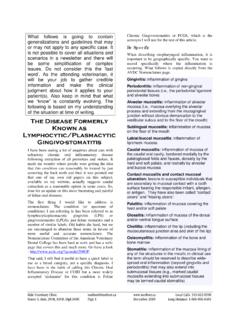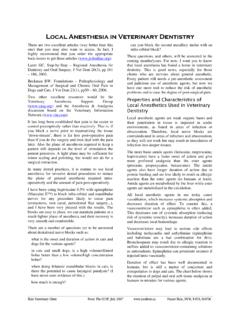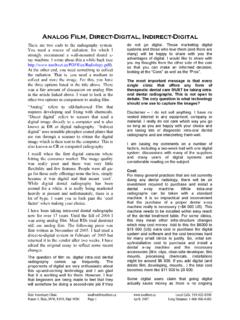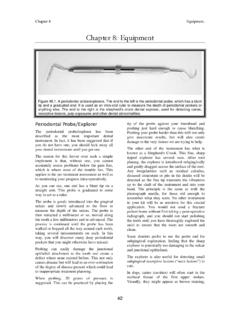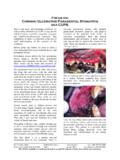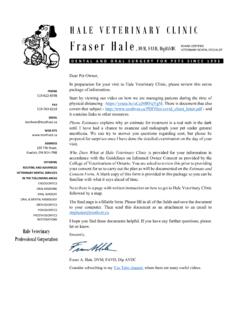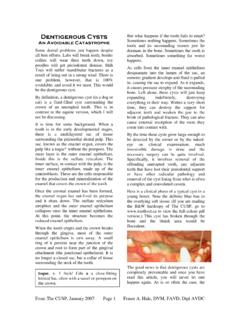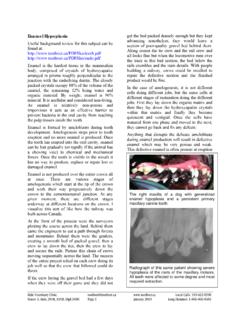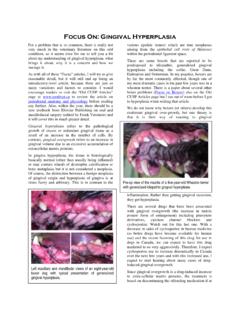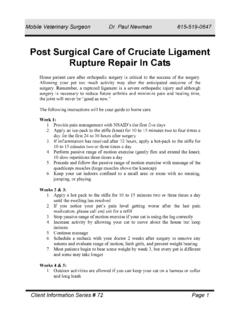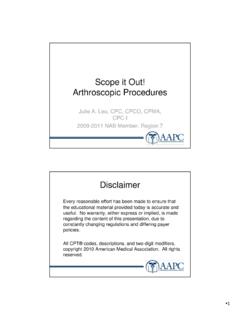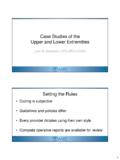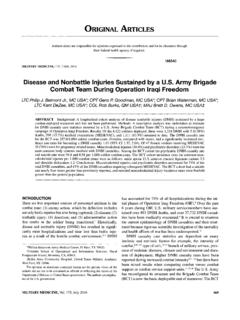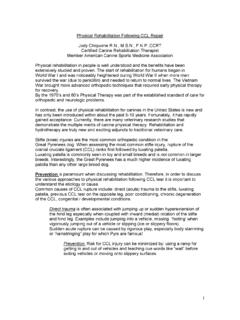Transcription of Chapter 21: Extraction - Fraser Hale
1 Chapter 21 Extraction . 164 Chapter 21: ExtractionThis Chapter is near the end of the book as Extraction is typically the last resort. I want you to think of other options before leaping to extract. Tooth Extraction , or exodontia, is the most common surgical procedure in most veterinary facilities. Though some seem loath to admit defeat and resort to toothanasia, it is frequently the most rational treatment option. Done properly, Extraction of diseased teeth can lead to a dramatic improvement in the health and well-being of the patient. Done poorly, continued suffering is the result. Therefore, every veterinarian, dentist or not, must make themselves proficient at Extraction and know when to refer cases beyond their skills.
2 Before we get into the How of extractions, I would like to get on my soapbox regarding the Who of extractions. Who Should be Extracting Teeth? When I speak to veterinary technician groups, I am usually asked for information on Extraction technique, particularly in regard to feline teeth with resorptive lesions. From these enquiries it is apparent that, in many practices, auxiliary staff are responsible not only for the decision to extract, but also for the surgery itself. This troubles me greatly and it seems to trouble many technicians as well. A cardinal rule of extractions is that they can be awfully simple or simply awful. In my experience, exodontia can be a very challenging procedure to perform properly and the opportunities for complications are many.
3 These complications include retained root fragments with persistent infection and pain, jaw fractures, chronic oro-nasal and oro-antral fistulae, delayed healing with chronic alveolitis and changes in occlusion leading to trauma to soft tissues in and around the mouth. I have repeatedly declined to teach technicians Extraction technique, citing the Ontario Veterinarian s Act, Practice Standards as support for my position. As it turns out, this document leaves the question open. To quote from Section 19; 1) "A member is responsible for the conduct of his or her auxiliaries and for the suitability and quality of the performance of their acts. (2) "A member is guilty of professional misconduct if an auxiliary of the member does or omits to do anything that, if done or omitted by a member, would constitute professional misconduct.
4 (3) "A member properly supervises the performance of an auxiliary's task if the member, (a) is physically present on the premises when the task is performed, remains available for personal intervention if required and monitors the performance to determine that the task is properly carried out; or (b) if absent on account of an emergency or otherwise temporarily absent and the performance of the task does not require the member's attendance, has given general instructions for such an occasion and the member ascertains as soon as practicable after the task is performed that it was properly carried out." Loosely interpreted, this section says that an auxiliary can do any surgical procedure, so long as the veterinarian feels the auxiliary is capable, the veterinarian is available to help and checks that the job was done properly.
5 In theory then, technicians would be allowed to do cruciate ligament repair, bone plating, enterotomies and so on. Now I doubt if any technicians are doing these procedures, because we all recognize that their training and experience do not prepare them for these complicated surgical procedures. In fact, I doubt if many technicians are neutering male dogs or removing cutaneous cysts. Why then, are technicians so commonly called upon to make oral diagnosis and perform extractions? My guess is that the answer is rooted in tradition. There was a time when only very loose teeth were extracted and so the decision to extract and the procedure itself offered little challenge. The tooth was just wiggled and if it popped out, the wound was left to heal by second intention.
6 Teeth that were firmly held in place were left to rot further to facilitate Extraction at a later date. In those days, a technician may have been able to do the job just fine. With the advances in veterinary dentistry in the past few years, extractions are no longer as simple as they once were. Clients demand a much higher level of dental care for their pets than ever before. Many want no less for their Chapter 21 Extraction . 165 pets in the way of medical and dental care than they receive themselves. Many conditions are now seen as solid indications for Extraction , even of teeth that are not the slightest bit loose. As well, treatment options other than Extraction are now available, even for seriously diseased teeth. Owners want to see their pets recover rapidly and comfortably.
7 To reduce post-operative pain and increase the chance of rapid, uneventful healing, most Extraction procedures also involve alveolar curettage, alveoloplasty and gingival flaps to close the wound and may include the placement of bone grafting materials for enhanced healing of the alveolus. One result of increased client expectations and advances in veterinary dentistry is that exodontia has become an intricate and delicate procedure involving careful treatment planning, radiography and radiology and hard and soft-tissue surgeries. In short, exodontia is no longer a procedure that can reasonably be delegated to auxiliaries. In recognition of the above, the Council of The College of Veterinarians of Ontario, in 2001, issued a Policy Statement that auxiliaries not diagnose, prognose, prescribe or perform major surgical procedures.
8 Major surgery includes any procedure that involves bone or entering a body cavity, among other criteria. Extraction involves diagnostic and prognostic evaluation and major surgery, so it is the Policy of the Council of the CVO that auxiliaries not perform extractions. In time, this policy may become law. In many jurisdictions in North America it already is. Some veterinarians may claim that it is not economically feasible for them to perform extractions. My answer to that is that they need to re-evaluate their fee structure for Extraction and make it economically feasible. Just imagine that you are in your dentist s chair for an Extraction and the dentists pops in to say Hi and then informs you that his/her assistant will be along in a moment to pull your tooth.
9 My guess is that you would be out the door in a flash. Exodontia should be performed by a licensed veterinarian who is very familiar with dental and paradental anatomy, physiology and pathology and who has accumulated the appropriate tools and skills. Some veterinarians really detest extractions. Rather that delegating to an auxiliary, they should consider referral to a veterinarian who enjoys dentistry and is properly equipped to do the job well. There are a number of such practitioners and the number is growing. Alternately, those who do not now enjoy dentistry might consider learning more about it and investing in some appropriate equipment. They may find that, once properly prepared, they find dentistry rewarding for their patients and for themselves.
10 Tips on Extraction Technique One of the tricks to successful Extraction , or any surgical procedure, is knowing what it is you are trying to accomplish. Of course, some teeth are so loose, you need only shake the animal's head and the rotters come flying out. On the other hand, how about those multi-rooted teeth with one rotten root and two others that are in as solid as a rock? How about cats with advanced resorptive lesions? To visualize what you are trying to do, you need to know the anatomy of the roots and those structures around them. Much of this has been covered in Chapter 7 but is reviewed here in a condensed version. Anatomy Review for Extraction : Each tooth has a specific number of roots, normally. In the dog, incisors, canines, first premolars and third lower molars all have one root, upper fourth premolars and upper first and second molars have three roots and the remaining teeth have two.
